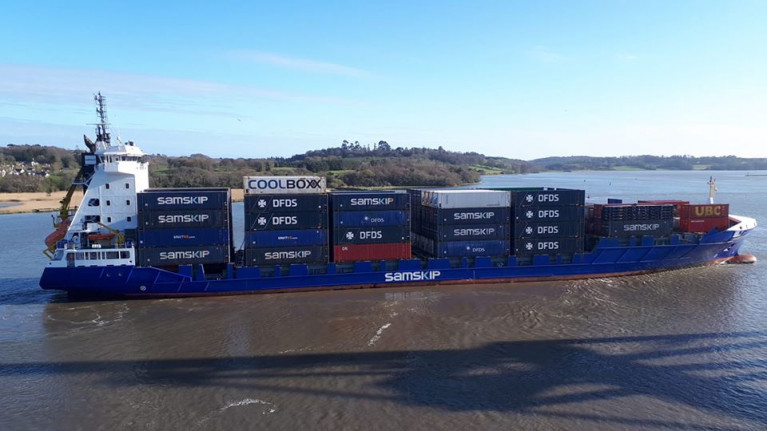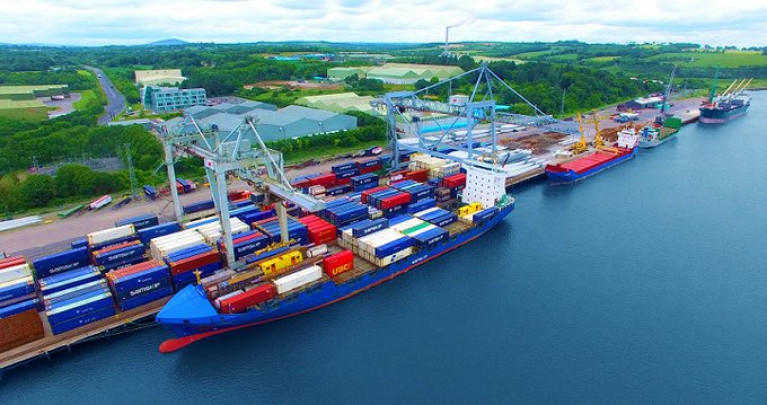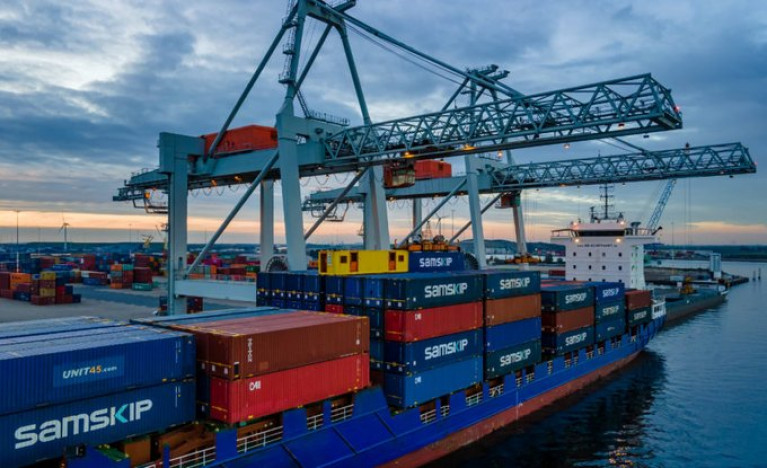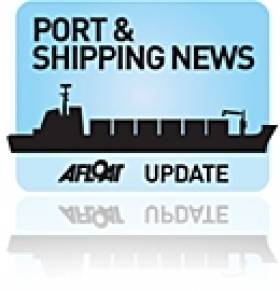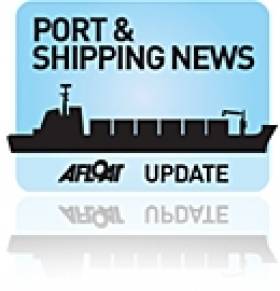Displaying items by tag: Samskip
Ireland-Europe BioFuel Containership Samskip Endeavour Makes Greener Future
Samskip a global logistics operator, has accelerated in expanding usage of biofuels in its shipping fleet, among them the 800TEU container vessel Samskip Endeavour which operates Amsterdam-Dublin, with the ship observed by Afloat taking anchorage in Dublin Bay this afternoon.
Initially starting with a 50% biofuel blend in the first half 2021 and switching to 100% biofuel after the summer period, the Samskip Endeavour was able to achieve a CO2 saving of 12.000 tons in 2021.
According to the Dutch operator based in Rotterdam, the ship has achieved a saving of more than 70% of CO2 emission when compared to traditional fuels. This translates into unburdening 200.000 trees from absorbing these emissions from the atmosphere over the course of ten years.
‘’Reducing fuel emissions and consumption is a critical next step for the maritime transport industry, so we are incredibly proud to lead this transition and to offer our customers a sustainable solution. Our efforts to provide green and clean shipping will only increase in the coming months and years,’’ says Ólafur Orri Ólafsson, Head of Sustainable Development at Samskip.
In 2018, the Samskip Endeavour was the first ever vessel to be biofuel-bunkered by the company’s longtime partner GoodShipping. These biofuels, which find their origin from fossil-free sustainable waste streams, have proved to be a successful substitute for conventional marine fuels, and can be used without making any modifications to the vessel’s engine.
Samskip was originally founded in Iceland in 1990 and since then has consistently grown by also offering transport and related services by land, rail and air. They have offices in Europe, North America, Africa, Asia and Australia.
Larger Samskip Ship Added Along With Waterford Call to Recently Launched Ireland-Amsterdam Link
In response to growing demand, Samskip has introduced a larger, faster containership, for its recently launched weekly container service between Dublin and Amsterdam by adding a call to the Port of Waterford.
The expansion comes less than five months after the debut of Amsterdam as a service separate from Samskip’s Rotterdam-Ireland links.
“We have experienced strong uptake for the direct route into Amsterdam’s network of rail, road and barge connections to major EU markets,” said Thijs Goumans, Head of Ireland Trade, Samskip. “As anticipated, customers linking to Ireland have been eager to avoid the post-Brexit hassles of UK distribution. Waterford can expect the same seamless connections.”
Monday night departures from TMA Terminal Amsterdam for arrival in Dublin on Wednesday complement Samskip’s existing Rotterdam-Ireland shortsea services, said Goumans. For Irish exporters, the weekend return to Amsterdam has also proved a key attraction.
“Samskip rail links between TMA and Duisburg connect Irish importers and exporters to markets farther east,” he said. “Adding Waterford brings new opportunities for Irish exports in the northern Netherlands, Germany, Poland and beyond.”
The service upgrade sees the introduction of the 750TEU capacity container ship Edith, whose faster operating speed accommodates a call in Waterford after the Dublin Port without any schedule disruption.
Samskip’s Rotterdam-Ireland services are sustained separately by a pair of 800TEU vessels.
“We are delighted by this expansion of Samskip’s Ireland service,” said Alma Prins-Droog, Head of Cargo & Offshore, Port of Amsterdam. “Since its inauguration last January, TMA Logistics and Samskip have worked tirelessly to make this service a success. This development highlights the position of the port of Amsterdam as a short sea hub, offering shippers efficient and reliable connections between Ireland and the European hinterland. We will continue to work with our partners to ensure success. The Irish container market shows strong growth, and the addition of the port of Waterford offers many new opportunities.”
Michael van Toledo, General Manager, TMA Logistics added: “Every week there has been a faster uptake of vessel slots on this route, demonstrating that the Amsterdam-Ireland link is a response to demand that was already there.
“TMA’s congestion-free road access provides a platform for growth in FMCG volumes into Ireland and for Irish pharma and dairy exports via Amsterdam, with Samskip rail services offering connections to the east and cross-docking at TMA is winning over trailer operators to and from markets further south of Amsterdam. over the past three years.''
Port of Waterford Chief Executive Frank Ronan said that the latest service development is built on a strong relationship between carrier and port, after a decade of calls by Samskip’s Ireland-Rotterdam services to Belview Container Terminal.
“The addition of a shortsea connection to Amsterdam by one of our leading service partners demonstrates the growth opportunities that exist in both directions for direct links between Ireland and other EU markets,” said Ronan.
“As the premier unitised facility in the south-east of Ireland, Waterford has capacity to handle more frequent direct lo-lo services into continental Europe, whether driven by local exports or rail freight containers moving across country,” said Ronan.
Samskip's New Dublin-Amsterdam Container Service Brings Irish Business to European Hinterland
In addition to the recent dramatic boost in direct ferry routes to mainland Europe, Samskip is ramping up its shortsea container services by introducing today an additional dedicated link connecting Amsterdam and Dublin Port.
The weekly connection will mean Irish imports can avoid post-Brexit hassles applying to goods received via UK-based distributors, while exports will benefit from greater reach into EU markets in the northern Netherlands, Germany and beyond.
Launching of the fixed day service involves a departure from the TMA Terminal Amsterdam today (Monday evenings) for an arrival in Dublin on Wednesday and a weekend return to the Dutch port. This complements Samskip’s existing Rotterdam-Ireland shortsea services by offering rail, barge and road customers in the Netherlands a new Monday night departure to Ireland.
Thijs Goumans, Head of Ireland Trade, Samskip, said that the service launch came at a time when importers and exporters in Ireland-mainland Europe trades continue to weigh up options as the consequences of Brexit for supply chain management became clear.
“The Ireland-North Continent freight market is in a dynamic phase, and fixed day container services to/from Amsterdam provide the certainty on which supply chain managers serving the Dutch and German markets can base business growth,” he said. Subject to initial moves, Samskip would consider calls to connect other ports in Ireland to Amsterdam direct.
“Shortsea container services can once more prove themselves more than a match for ro-ro, particularly for products previously shipped to distributors in the UK then redistributed across the Irish Sea,” said Richard Archer, Regional Director, Samskip Multimodal. “Amsterdam is a high-performance port connecting straight into the hinterland area and the entire Samskip Ireland team is delighted by this new commitment to pan-European transport.”
Koen Overtoom, CEO Port of Amsterdam, commented: “We are very pleased with this expansion of the port’s short sea network. It underlines the strength of the services Samskip and TMA Logistics offer, as well as our strategic position. Ireland is a key market, and in these rapidly changing times a direct link presents tremendous opportunities. We will continue to work with TMA, Samskip and international partners to make this service a lasting success.”
Michael van Toledo, General Manager TMA Amsterdam, said Samskip’s rail links to Duisburg and TMA’s congestion-free road access offered a platform for growth in FMCG volumes into Ireland and pharma and dairy exports moving the other way. “The service could have been custom-made for our ambitions to grow Amsterdam as a hub for shortsea container business,” he said. “It targets the greater appetite for direct North Continent services to Ireland post-Brexit, with TMA’s cross-docking winning over trailer operators in markets further south.”
Afloat add that Samskip operate existing direct container routes to Irish Ports linking Rotterdam involving Dublin, Waterford, Cork in addition a service to Belfast.
As mentioned in the photo-caption, the Irish links with the Dutch operator also include Iceland where the company had its origins dating to 1990. In the following decade Samskip acquired a former Aran Islands ferry, Oileáin Árann which served notably as the final passenger/cargoship based out of Galway, until sold to Samskip and renamed Sæfari.
Drifting Cargoship Rescued off Cornish Coast Completes Voyage
#DriftingCargoship – A drifting cargoship on the way from Rotterdam to Ireland has been rescued off Plymouth by the RNLI, coastguard and a Dutch tug.
The Plymouth Herald writes that the 130m ship suffered engine failure and began dragging anchor off the south coast of Cornwall.
The Samskip Express was drifting three miles off Porthleven but, according to coastguards (on Friday), is now anchored awaiting rescue. It is said to be steady in 35 knot winds and a four metre swell.
A spokeswoman for the Maritime and Coastguard Agency (MCA) said a tug had been sent to the ship and Penlee lifeboat summoned to assist getting a line to the vessel. For more coverage, click here.
In an update, Afloat adds that engine problems with Samskip Express have since been resolved and that the 803 TEU capacity containership was able to continue her voyage from Rotterdam. Last night the vessel berthed in Dublin Port.
The 2006 built containership operated by Samskip based in the Netherlands, though originally an Icelandic company formed in 1990, operate the vessel on a routine ‘feeder’ liner service to Dublin.
Samskip Express is scheduled to make her next departure around noon today bound for Waterford (Belview) the port's main terminal located downriver of the city. Also they operate services between Rotterdam to Belfast and Cork.
Samskip’s Dutch-Irish services form only part of a much wider route network throughout Europe, to northern Russian ports and on the Black Sea and to Georgia. In addition Europe-USA routes to ports on both the Atlantic and Pacific coasts.
#SamskipSulphur – Samskip CEO, Diederick Blom has said that new sulphur regulations will increase line's bunker bills by 50%, according to LloydsLoadingList.com
The CEO added the increasing costs of fuel resulting from new low-sulphur fuel regulations may drive a shift back to road transport on certain European shortsea routes.
Some operators had already closed services anticipating a modal shift in favour of road transport when new rules come into force in January, although he felt this would be a short-term development. "Longer term we expect transport by sea and rail will increase and by more than road," he said.
"The European white paper on transportation says that one third of road traffic that travels more than 300 km will have to be off the road by 2030 and in total 50% will need to be off the roads by 2050. So the European Commission will have to make road transport less efficient than it is today in an attempt to support transportation by sea and by rail."
Samskip is expecting its fuel costs to increase by 50% as a result of the new sulphur regulations that will force it to switch to more expensive marine gas oil.
Blom said that most of the carrier's shortsea operations are conducted in the Baltic Sea, North Sea, English Channel and North America.
These emission-control areas will be subject to a 0.1% sulphur limit from January 1, 2015, up from the current 1% limit. For more on the impact of sulphur regulations, click HERE.
In July of this year, Samskip Multimodal announced a new part-load service between Italy and Ireland.
Container Ship Successfully Refloated in Waterford Harbour
In attendance was Bargarth, a UK-flagged tug based in Waterford and operated by Fastnet Shipping. The twin Voith & fire-fighting tug made a special appearance during the Tall Ships Races Parade of Sail on 3 July, when she put on a celebratory water-display off Dunmore East.
Samskip Eandeavour is capable of handling 812 twenty-foot equivalent containers (TEU). She was completed only this year by Damen Gorinchem Scheepswerf B.V. Foxtol in the Netherlands. The vessel is operated by an Icelandic company, Samskip which provides several container feeder-liner services between Rotterdam / Zeebrugge with Belfast, Dublin, Cork and Waterford.
After unloading and loading at Belview the 140m vessel is scheduled to dock in the Port of Cork tomorrow at the Tivoli Container Terminal before returning to Europe.


























